NEWS CENTER
Research Progress on Surface Coating of Zirconium Alloy Cladding
- Time of issue:2018-10-25 18:35
(Summary description)In the past few decades, zirconium alloy cladding has been successfully applied to light water reactors (LWR), showing good radiation resistance and corrosion resistance. However, a major problem in the application of zirconium alloy stacks is that it reacts violently with water vapor at high temperatures, and releases a large amount of hydrogen and heat when the temperature is greater than 1200°C.
Research Progress on Surface Coating of Zirconium Alloy Cladding
(Summary description)In the past few decades, zirconium alloy cladding has been successfully applied to light water reactors (LWR), showing good radiation resistance and corrosion resistance. However, a major problem in the application of zirconium alloy stacks is that it reacts violently with water vapor at high temperatures, and releases a large amount of hydrogen and heat when the temperature is greater than 1200°C.
- Categories:Industry News
- Author:
- Origin:Key Laboratory of Reactor Fuel and Materials
- Time of issue:2018-10-25 18:35
- Views:
In the past few decades, zirconium alloy cladding has been successfully applied to light water reactors (LWR), showing good radiation resistance and corrosion resistance. However, a major problem in the application of zirconium alloy stacks is that it reacts violently with water vapor at high temperatures. When the temperature is greater than 1200 ℃, a large amount of hydrogen and heat will be released. After the Fukushima nuclear power accident in Japan, the safety of nuclear power was once again placed in front of all nuclear workers. How to further improve the safety and reliability of light water reactor nuclear fuel elements under accident conditions has become an urgent problem to be solved.
The challenge faced by light water reactor nuclear fuel elements is the development of accident-resistant fuels to meet the higher safety margin requirements of reactor design for fuel performance. The research and development directions of accident-resistant fuels that scientists have proposed include accident-resistant fuel cores and accident-resistant cladding materials. Accident-resistant cladding materials are dedicated to improving the reaction kinetics of zirconium and water vapor, reducing the rate of hydrogen release, and the cladding should have good thermodynamic properties. The development of accident-resistant cladding materials is mainly reflected in two aspects: one is to improve the high-temperature oxidation resistance and strength of zirconium alloy cladding; the other is to develop non-zirconium alloys with high strength and oxidation resistance. This article discusses the research on the surface coating of zirconium alloy cladding for the former.
The main advantage of the application of coated zirconium cladding is economy, because the production capacity of existing equipment can be used continuously, and it is easy to realize the commercial application of zirconium-based coated cladding. The technical challenge facing the coated zirconium cladding is to meet the various performance requirements of the fuel cladding and components, and the coated cladding does not change the size of the fuel cladding, which is critical to the performance of the reactor, especially during normal operation. Under conditions. In the long-term operation process, the coating should have certain stability under the conditions of corrosion, creep and abrasion. Therefore, it is necessary to continuously explore and optimize the preparation technology of zirconium alloy surface coating.
The new technology should make it easier to control the quality of the coating, especially the thickness of the coating. The surface coating of the zirconium cladding should be able to maintain long-term stability in the reactor environment.
At present, the international research on the surface coating of zirconium alloy cladding is still in the early stage of exploration. A series of candidate coating materials and coating processes have been screened, and the coating performance has also been characterized, and some results have been achieved. The United States has mainly focused on MAX phase and ceramic coating materials, South Korea and France have focused on metallic Cr coating materials, and the research on surface coating of zirconium alloy cladding in China is still in its infancy.
1. Research status of zirconium alloy cladding surface coating
Zirconium alloy surface anti-oxidation coating technology is a main method to improve the oxidation resistance of the zirconium cladding surface. The outer surface of the zirconium alloy is coated with a layer of material to enhance the wear resistance and high temperature oxidation resistance of the cladding, thereby improving the accident resistance performance of the zirconium cladding under normal working conditions and accident conditions. At present, international studies on the surface coating of zirconium alloy cladding have made some preliminary screening results, and the coating materials mainly involve MAX phase and metallic Cr.
1.1 MAX phase coating
The U.S. Department of Energy emphasized the application advantages and research recommendations of MAX phase materials in the 2014 Young Water Reactor Cladding Structure Materials Research Proposal. Benjamin of the University of Wisconsin in the United States selected Ti2AlC material in the MAX phase as the surface coating material for the zirconium cladding. The coating process used cold spraying and the coating thickness was about 90 μm. The test results show that the bonding force between the coating and the zirconium substrate is greater than 50 N, and the wear resistance of the MAX phase coating surface is better (Figure 1). After the high temperature oxidation experiment at 700 ℃ for 60 min, no oxide layer was observed between the coating and the substrate interface, only the upper surface of the zirconium alloy coating was slightly oxidized, and the oxide film thickness of the Zr-4 alloy under the same conditions reached 10 μm, this is because a dense and stable protective film is formed on the surface of the coating. The high temperature oxidation test results under simulated accident conditions show that the coating has a protective effect on the zirconium substrate.

Darin J. Tallman et al. studied the reactivity of MAX phase materials Ti3SiC2 and Ti2AlC with Zr-4 alloy when the temperature is in the range of 1100~1300 ℃. The research results show that the diffusion thickness of Si and Al conform to the parabolic law, and both Zr-Si and Zr-Al intermetallic compounds are formed, but the diffusion rate of Si to Zr-4 alloy is one order of magnitude less than that of Al diffusion.
The Ningbo Institute of Materials, Chinese Academy of Sciences in China has also carried out MAX phase material coating research, and carried out preliminary exploration tests of different coating materials and different coating processes. The institute focused more on the discussion of the coating mechanism, pointing out that the essence of MAX phase coating is dressing, and the key to the problem lies in solving the diffusion of oxygen atoms into the zirconium matrix. ZongjianFeng et al., Ningbo Institute of Materials, Chinese Academy of Sciences, prepared Ti2AlC coatings by DC magnetron sputtering and studied the control of coating composition. 316L austenitic stainless steel was selected as the base material, and the coating thickness was about 10 μm. After the high temperature oxidation test of Ti2AlC coating samples in 750 ℃, air or pure water vapor environment, the oxidation delamination phenomenon and oxidation mechanism were carried out. Discussed. The oxidation test results of Ti2AlC coating in air show that the sample has formed four layers: the outermost layer is a thick mixed oxide of Al2O3 and TiO2, followed by a thin α-(Al,Cr)2O3 underlayer, and a thick Fe2O3 in the middle. Mixed oxide with TiO2, the inner layer is a thin Al2O3 enriched layer. The oxidation results in pure steam water showed that the inside of the sample was oxidized, and the Ti2AlC coating did not form a clear oxide layer, which may be related to the quality control of the coating. Therefore, the use of magnetron sputtering to prepare alloy surface coatings remains to be further studied.
E.N. Hoffman et al. [6] analyzed the core application and neutron transmutation performance of MAX carbide materials in future nuclear power plants. Commercially pure MAX phase materials were placed in fast neutron reactors and thermal neutron reactors for 10 years, 30 years and 60 years, and their neutron activities were simulated and calculated. The simulation analysis results show that, no matter in the fast neutron reactor or the thermal neutron reactor, under the three activation time conditions, the activity of the MAX phase material is similar to that of SiC, but three orders of magnitude lower than that of 617 alloy.
Ti3SiC2, Ti3AlC2 and Ti2AlC three MAX phase materials neutron irradiation test results also verify the rationality of the neutron irradiation simulation analysis results. Ian Younker et al. evaluated the neutron properties of coating candidates for accident-resistant fuels, and the results showed that the thickness of the MAX phase coating should be controlled within 10-30 μm to limit the loss of neutrons. Darin J. Tallman et al. studied the defect evolution behavior of Ti3SiC2 and Ti2AlC materials during neutron irradiation, and showed that as a candidate material for MAX phase coatings for high-temperature nuclear energy applications, Ti3SiC2 has a better prospect than Ti2AlC. Qing Huang et al. [9] also studied the radiation resistance of the MAX phase materials Ti3SiC2 and Ti3AlC2. The results show that the radiation resistance of Ti3AlC2 is better than that of Ti3SiC2 at room temperature, and the two MAX phase materials are irradiated at 600 ℃. Photo stability is better than room temperature.
The reported results indicate that as an accident-resistant cladding coating material, MAX phase is a promising candidate material, but the coating preparation process needs to be further screened and optimized. The research work on the in-reactor application performance of the MAX phase coating cladding also needs to be further carried out.
1.2 Metal Cr Coating
In order to reduce the oxidation rate of zirconium-based alloys in high-temperature water vapor environments, Korea Atomic Energy Institute (KAERI) Hyun-Gil Kim and others have explored related coating materials and coating technologies. 3D laser coating technology was used to prepare a Cr coating on the surface of zirconium alloy with a thickness of 90 μm. The adhesion of the zirconium alloy surface coating was tested, and a high-temperature oxidation test was carried out. The research results show that, due to the formation of the intermediate diffusion layer, the Zr-4 alloy and the Cr coating have excellent adhesion. The Cr-coated cladding has no cracks until 4% strain (Figure 2), which meets the 1% strain requirement of the fuel cladding. The oxidation test data shows that the high temperature oxidation resistance of the coated zirconium alloy is significantly better than that of the Zr-4 matrix.
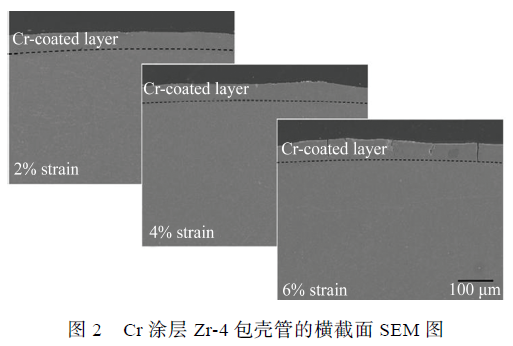
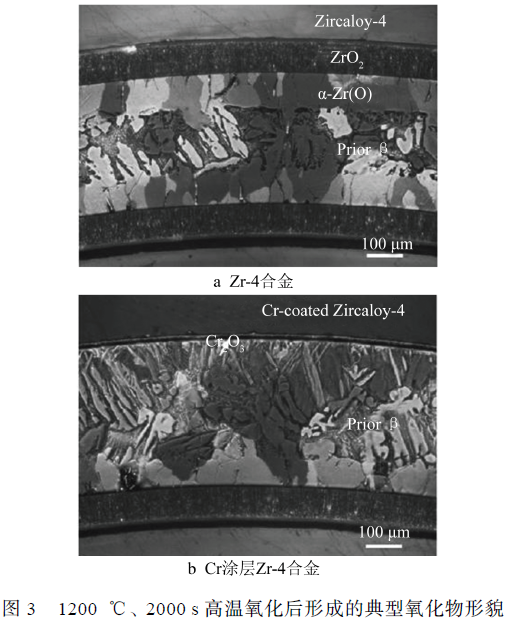
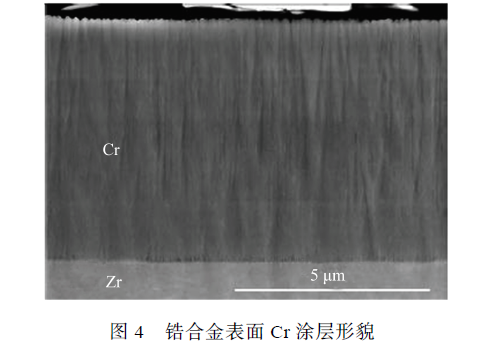

Studies have shown that the metal Cr coating has good high temperature oxidation resistance and can be used as a candidate material for accident-resistant zirconium alloy cladding.
At present, the research on the surface coating of zirconium alloy in the United States is mainly focused on MAX phase materials, including the coating process, the high temperature oxidation performance of the coated zirconium alloy, and the radiation performance of the coating material. South Korea and France have focused on the preparation process and high-temperature oxidation performance of metallic Cr coatings. The preparation process and some properties of MAX phase materials have also been pre-explored in China. Since the research on the surface coating of zirconium alloy cladding is in the stage of feasibility exploration, the reports on the application performance of the coating mainly focus on the high temperature oxidation and corrosion performance, and the research on other application performance needs to be further developed.
2. Several key issues in the study of zirconium alloy surface coatings
2.1 Coating material selection
Considering the special application environment, the choice of cladding coating material is mainly based on its physical properties. First, the coating material should improve the high temperature oxidation resistance of the zirconium cladding. Under accident conditions, the coated zirconium cladding should exhibit a significantly low oxidation rate, and a dense and stable protective film can be formed on its surface to prevent or delay the further aggravation of oxidation, thereby preventing the zirconium cladding from being damaged due to loose oxidation. . When selecting the zirconium cladding coating material, in addition to considering the necessary high-temperature oxidation resistance, the melting point, thermal conductivity, and mechanical properties of the candidate material under temperature gradients, as well as its neutron economy, must also be considered.
Considering the above factors comprehensively, the two ceramic materials, Cr2O3 and Al2O3, have outstanding performance, with low growth rate at high temperature and very stable. Due to its brittleness, if a ceramic layer is directly formed on the surface of the zirconium alloy, it will easily crack during the preparation of nuclear fuel machinery. Considering the compatibility with the zirconium alloy, if the coating material can form a ceramic oxide film on the surface of the cladding during high-temperature oxidation reaction, it will be more stable. Metallic Cr and MAX phase materials can form a dense protective film after high temperature oxidation, and they are promising candidates for zirconium cladding coatings.
2.1.1 MAX phase
Since 2000, the new MAX phase materials have combined some of the excellent properties of metals and ceramics. The MAX phase material has good plastic deformation ability. This microplasticity and good thermal conductivity make the material have good thermal shock resistance, and the microplasticity also makes it have good damage resistance. Table 1 and Table 2 respectively show the typical physical and mechanical properties of some commonly used MAX phase materials.


It can be seen that the four alloys of Ti2AlC, Ti3AlC2, Ti3SiC2 and Cr2AlC have some excellent properties of metal and ceramic materials and have good overall properties.
Studies have shown that the MAX phase material is an excellent high temperature resistant structural material. Table 3 shows the parabolic rate constants of some commonly used MAX phase materials when oxidized at 1000~1300 ℃ in the air. The resistance of these MAX phase materials can be known. High temperature oxidation performance is better. Generally speaking, the oxidation resistance of Ti3AlC2 is better than Ti3SiC2, which is about 2 to 3 orders of magnitude higher. The reason for its good oxidation resistance is the formation of a dense Al2O3 protective film after surface oxidation. Ti2AlC also has good oxidation resistance, and its oxidation mechanism is the same as Ti3AlC2. The high temperature oxidation resistance of Cr2AlC is very good, comparable to Ti3AlC2, but its thermal expansion coefficient (13.3×10-6 K) and the thermal expansion coefficient of the zirconium matrix (7.2×10-6 K) are too different, which is not conducive to coating quality control. The high-temperature oxidation resistance of Ti3SiC2 material is relatively poor. As the temperature increases, the oxidation rate increases significantly, and the oxide film produced is a ceramic material SiO2 with very low thermal conductivity, which is not conducive to heat dissipation inside the cladding. After Ti3AlC2 and Ti2AlC are oxidized, a dense Al2O3 protective film is formed. The thermal expansion coefficient of the film (8.4×10-6 K) and the zirconium alloy (7.2×10-6 K) have a small difference. Although Ti3AlC2 has better high-temperature oxidation resistance than Ti2AlC, considering neutron economy, Ti2AlC is a more ideal candidate for zirconium alloy cladding coating.
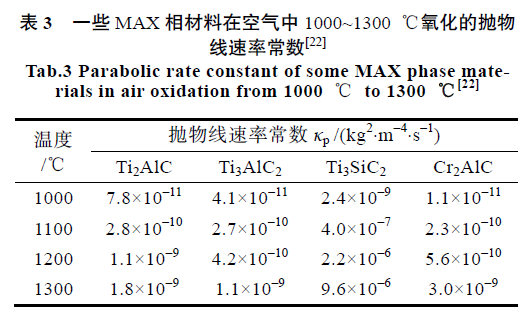
2.1.2 Metal Cr
Metal Cr has good metallic luster and corrosion resistance, and is often used for plating on the surface of other alloys. High-purity metal Cr has the advantages of high temperature resistance, oxidation resistance, vibration resistance and creep resistance. It can be used as a target material for various plasma and electron beam sputtering and has a wide range of applications.
Korea Atomic Energy Research Institute Hyun-Gil Kim conducted research on the high-temperature oxidation performance of coating candidate materials, and the test results are shown in Table 4.
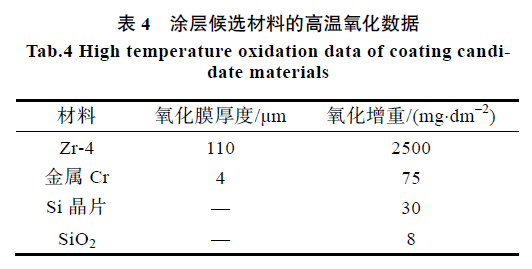
After oxidation in a water vapor environment at 1200 ℃, among the four candidate materials, SiO2 has the best high temperature oxidation resistance, and Si is more effective than Cr in oxidation resistance. He also carried out a corrosion test under simulated operating conditions of 360 ℃ and 18.9 MPa. The results showed that Cr metal exhibits better corrosion resistance than Zr-4 alloy, while Si wafers and SiO2 samples dissolve quickly under corrosive conditions, namely Materials with good oxidation resistance in high-temperature water vapor environments cannot guarantee their corrosion stability under normal operating conditions in the reactor. Therefore, KAERI chose metallic Cr alloy as the coating material for the zirconium alloy cladding. French CAE is also committed to the research of metallic Cr coatings. It has investigated more than 20 coating materials based on Zr-4, including ceramics and metals, and found that metallic Cr coatings have the most potential for development. Studies have shown that metallic Cr is also a promising candidate material for zirconium alloy coatings.
2.2 Coating process selection
In order for the coated zirconium cladding to provide effective protection under accident conditions, the surface coating must be uniform and dense, with good high temperature oxidation resistance. Therefore, the control of the quality of the surface coating is very important, especially the film-base adhesion and film density, which depend on the deposition technology and process parameters used. The process of preparing the coating is best carried out under the conditions of vacuum protection, and its preparation efficiency is high, and most importantly, it is suitable for the preparation of fuel assembly coatings. Generally speaking, the coating deposition temperature should be lower than the final annealing temperature of the zirconium cladding, about 500 ℃, to avoid changes in the microstructure of the zirconium alloy matrix. Comprehensive comparison of the advantages and disadvantages of different surface preparation technologies, arc ion plating technology is a promising process for preparing zirconium cladding surface coatings.
2.2.1 Thermal spraying
Thermal spraying includes flame spraying, arc spraying, plasma spraying and supersonic flame spraying. The coating and the substrate mainly rely on mechanical bonding, and the bonding strength of the interface is relatively low, so the impact resistance is not good. During the thermal spraying process, there will be problems such as powder oxidation, phase change, decarburization or changing the physical and chemical properties of the original powder, and at the same time it will have an adverse thermal effect on the substrate. Small-area thermal spraying is economical, and the thickness of the coating is generally 0.5~5 mm. The coating material should be selected as close as possible to the thermal expansion coefficient of the substrate.
Relatively speaking, the porosity of the plasma sprayed coating is lower, and the bonding strength between the coating and the substrate is higher. However, plasma spraying is more suitable for coating thick films, and it is difficult to control the quality of coatings that are tens of microns thin on the surface of zirconium alloys. Korea adopted the plasma spraying PS (PlasmaSpraying) technology in the early stage, but there are some technical problems, such as the formation of pores in the Si coating, and oxidation of the interface layer due to low bonding force. After the improved process, the coating prepared by plasma spraying is processed by laser beam scanning LBS (Laser Beam Scanning) to remove the pores in the Si coating and inhibit its oxidation due to the formation of a diffusion layer at the interface. However, the manufacturing cost of the coating has increased sharply, the product quality control is difficult, and the PS+LBS preparation process is complicated, and this process has not been adopted.
2.2.2 Cold spray
Cold spraying is a coating formed by strong plastic deformation when high-speed powder particles hit the substrate at a low temperature. The cold spray process has the advantages of low deposition temperature, small thermal impact on the substrate, uniform distribution, and basically no oxidation of the coating. Therefore, cold spraying is mainly used for spraying temperature sensitive materials, oxidation sensitive materials or phase change sensitive materials. The deposition rate of cold spray is very high, and the coating can obtain a relatively large thickness. In contrast, the bonding strength between the cold spray coating and the substrate is not high, but it can achieve lower porosity and relatively high bonding strength at the expense of a certain deposition rate.
Xi'an Jiaotong University and Ningbo Institute of Materials, Chinese Academy of Sciences both have the basis for cold spraying process research and coating performance characterization method research. The spraying process of the former can be carried out under vacuum or atmosphere protection. It is difficult to achieve thin coatings of tens of micrometers by cold spraying, and the effect of high-speed deposition of coating particles on the deformation of about 0.6 mm thin-walled zirconium tubes in the cold spraying process remains to be explored. The cold sprayed film layer and the substrate are mechanically bonded, and the bonding strength is relatively low. Heat treatment can be used to improve the bonding force of the film substrate. In order to obtain high-quality coatings, cold spraying has certain requirements on powder particle size and impurity content, which also brings about problems in powder preparation technology research. At present, the preparation technology of MAX phase material powder at home and abroad is relatively mature, and cold spraying technology can be used to explore the surface coating technology of zirconium alloy.
2.2.3 Vapor deposition method
Material surface engineering preparation technology. Vapor deposition methods are divided into physical vapor deposition (Physical Vapor Deposition-PVD) and chemical vapor deposition (Chemical Vapor Deposition-CVD). The chemical vapor deposition process is mostly carried out under relatively high pressure and high deposition temperature (900~1200 ℃). Considering that the coating preparation process should try to avoid the influence on the zirconium matrix structure, the deposition temperature should be as low as possible. Therefore, the preparation process of the zirconium alloy surface coating can adopt the physical vapor deposition method with a relatively low deposition temperature.
At present, the commonly used physical vapor deposition methods are mainly magnetron sputtering and ion plating. Magnetron sputtering has good film-forming effect, low substrate temperature and strong film adhesion, especially suitable for large-area coating. The substrate temperature in the magnetron sputtering process is one of the most important factors affecting the microstructure and performance of the coating. A suitable substrate temperature can improve the adhesion and deposition speed of the film. The film prepared by magnetron sputtering technology is of good quality, but the deposition rate is low and the film is relatively thin. Generally, the thickness of the film can reach several microns, but it takes a long time to deposit a coating of several microns, and the residual stress of the film is large. The feasibility of using magnetron sputtering method to prepare zirconium cladding surface coating needs to be further explored.
The deposition temperature of ion plating technology is significantly reduced, which is beneficial to reduce or eliminate the thermal stress between the coating and the substrate and improve the bonding force of the coating. Arc ion plating has the advantages of good deposited coating quality, high deposition rate, strong diffraction, and large area deposition. The disadvantage of this process is that spray particles are easily generated during the deposition process, which affects the quality of the film, which can be improved by techniques such as magnetic field filtering. As a cathode target, the coating material must have a certain degree of conductivity. Both MAX phase and metallic Cr materials have conductivity. If they are made into suitable target materials, the surface coating of zirconium cladding can be prepared. Aiming at the research of zirconium alloy surface coating, arc ion plating technology is a promising coating preparation process.
2.3 Coating quality characterization
Candidate materials for high temperature oxidation resistant coatings, such as MAX phase and metallic Cr, have relatively high thermal neutron absorption cross sections. Considering the economy of neutrons, the thickness of the zirconium cladding surface coating should be designed to be as thin as possible. In the research of coating preparation process, the characterization of coating quality is very important. The coating structure and performance characterization mainly include chemical composition and phase structure, micro morphology, micro hardness, coating thickness and coating adhesion.
Optimize the coating preparation process by comparing the coating quality characterization results. X-ray diffraction (XRD) is generally used to analyze the crystal structure of the coating and the changes in the surface phase structure of the coating and the substrate. An energy spectrometer (EDS) is used to analyze the composition of the coating, the substrate, and the distribution of the elements at the interface between the coating and the substrate to determine whether the control of the coating composition and phase structure by the preparation process meets the technical requirements.
Using scanning electron microscope (SEM) to observe the coating surface and interface morphology, including pores, surface morphology, structure and coating thickness, etc., to analyze the uniformity of the coating distribution. When measuring the thickness from the cross-section of the coating, it is necessary to prevent the chamfering of the cross-section sample caused by the metallographic polishing. Porosity is a measure of the compactness of the coating, and it is an important indicator that affects the corrosion resistance of the coating. The hardness tester is used to detect the microhardness that can reflect the performance of the coating.
Coating adhesion is the most critical performance index for evaluating the quality of coatings. Conventional testing methods include indentation, scratching, and stretching. The coating should maintain its integrity when the zirconium cladding tube undergoes circumferential deformation, no matter in normal operation of the reactor or under accident conditions. At room temperature, hoop tension and compression tests can be used to evaluate the bond strength between the coating and the substrate for the coated zirconium cladding tube.
2.4 Research on key application properties of coated zirconium cladding
The quality of the coating has a significant impact on the corrosion resistance of the zirconium cladding. For the same coating material, the better the coating density and the lower the porosity, the better the corrosion resistance of the coated zirconium cladding. The zirconium cladding material will undergo creep, fatigue and thermal shock in the reactor. Therefore, the bonding strength between the coating and the substrate will directly affect whether the coating technology can be used for the research of zirconium alloy cladding materials.
Good coating quality is to better meet the application performance requirements of zirconium alloy cladding. The application performance research results of the coated zirconium cladding are fed back to the coating preparation process in time to continuously optimize the preparation process parameters and obtain high-quality surface coatings. Considering the impact of coating quality, it is necessary to study the key application performance of zirconium alloy coating outside the reactor, mainly focusing on whether the coating zirconium cladding can achieve the coordination and consistency between the coating and the zirconium matrix during the operation of the reactor.
2.4.1 High temperature oxidation performance
Improving the high temperature oxidation resistance of zirconium cladding is the key to the development of accident-resistant fuel cladding. Therefore, it is first necessary to study the high temperature oxidation performance of the coated zirconium alloy. A comprehensive thermal analyzer was used to study the high-temperature oxidation performance of the coated zirconium alloy. A stream of water vapor was introduced during the test, and the temperature range was 700 to 1300 ℃. According to the experimental results, the oxidation kinetic curve of the coated zirconium alloy was analyzed, the microscopy and scanning electron microscope were used to observe the structure of the oxide film on the sample surface, and the energy spectrum analyzer was used to analyze the oxide film composition.
2.4.2 Corrosion performance
The zirconium cladding material that has been in service for a long time in the reactor needs to have good corrosion resistance. The corrosion test of the coated zirconium alloy is carried out in a static autoclave. The test result analysis method is the same as that described in the high-temperature oxidation performance, mainly including the oxidation kinetic curve study and the surface morphology and composition analysis of the oxide film.
2.4.3 Thermal shock performance
The accident-resistant cladding material should have good thermal shock resistance and will not rupture under accident conditions to avoid the release of radioactive fission products. The test is to keep the sample in a high-temperature, high-pressure water vapor environment for a period of time to quickly cool it down. The microscopic microscope and scanning electron microscope were used to observe the surface structure of the sample and the bonding between the coating and the substrate, and to analyze the thermal shock resistance of the coated zirconium alloy.
2.4.4 Creep performance
Compared with the zirconium substrate, the creep performance of the coated zirconium alloy is studied, and the influence of temperature and stress on the creep resistance of the coated zirconium alloy is analyzed. During the test, observe whether the coating will peel or fall off. Scanning electron microscope was used to observe the morphology of the port and analyze the deformation coordination between the coating and the substrate.
3. Conclusion
The research on the surface coating of zirconium alloy cladding is a major aspect of the development of accident-resistant fuel, which has the advantages of good manufacturing economy and easy commercialization. At present, the international research on zirconium alloy surface coating technology is still immature and in the exploratory stage of continuous demonstration. The systematic investigation of the existing coating materials and coating process research has laid a good foundation for the research work on the surface coating of zirconium alloy in my country. As coating candidate materials, Ti-Al-C MAX phase materials and metallic Cr have good application prospects. The selection of coating materials and coating processes for zirconium alloy cladding is a complicated process, which needs to be repeatedly verified based on the results of subsequent research on key application performance of the coating. All in all, the international research on zirconium alloy surface coating technology is not yet fully mature, and it is in the stage of multi-party exploration and continuous demonstration. This also brings opportunities and challenges to my country's zirconium alloy surface coating technology research.
Hot News

黄石山力科技股份有限公司
Sunny Technologies Incorporation Limted

Contact us
Add:No. 2, Guangzhou road, tuanshancheng Development Zone, Huangshi City, No. 101, Gaoxin 6th Road, Donghu New Technology Development Zone, Wuhan
Mail:spt@sunnychina.com.cn
Tel:156 7177 7755 / 027-59715061
Fax:027-59715060





